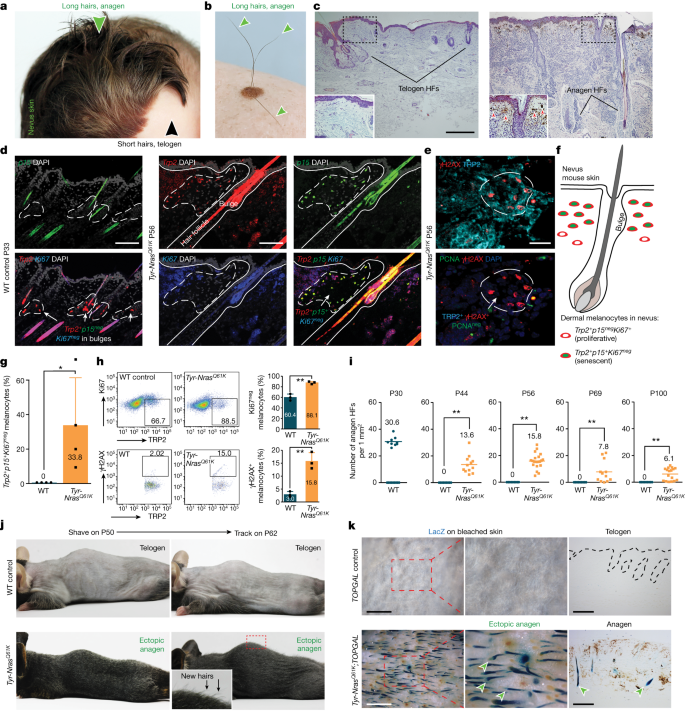2023-06-21 カリフォルニア大学校アーバイン校(UCI)
◆この発見は、男女の一般的な脱毛症である男性型脱毛症に対する新しい分子療法の可能性を提供するとされています。研究はマウスモデルを用いて行われ、ネズミのホクロと人間のホクロサンプルの分析も行われました。今後の研究で、さらなる有効な活性化因子の特定が期待されています。
<関連情報>
- https://news.uci.edu/2023/06/21/uc-irvine-led-researchers-reveal-new-molecular-mechanism-for-stimulating-hair-growth/
- https://www.nature.com/articles/s41586-023-06172-8
老化メラノサイトによるシグナル伝達が毛髪成長を亢進させる Signalling by senescent melanocytes hyperactivates hair growth
Xiaojie Wang,Raul Ramos,Anne Q. Phan,Kosuke Yamaga,Jessica L. Flesher,Shan Jiang,Ji Won Oh,Suoqin Jin,Sohail Jahid,Chen-Hsiang Kuan,Truman Kt Nguyen,Heidi Y. Liang,Nitish Udupi Shettigar,Renzhi Hou,Kevin H. Tran,Andrew Nguyen,Kimberly N. Vu,Jennie L. Phung,Jonard P. Ingal,Katelyn M. Levitt,Xiaoling Cao,Yingzi Liu,Zhili Deng,Nobuhiko Taguchi,Vanessa M. Scarfone,Guangfang Wang,Kara Nicole Paolilli,Xiaoyang Wang,Christian F. Guerrero-Juarez,Ryan T. Davis,Elyse Noelani Greenberg,Rolando Ruiz-Vega,Priya Vasudeva,Rabi Murad,Lily Halida Putri Widyastuti,Hye-Lim Lee,Kevin J. McElwee,Alain-Pierre Gadeau,Devon A. Lawson,Bogi Andersen,Ali Mortazavi,Zhengquan Yu,Qing Nie,Takahiro Kunisada,Michael Karin,Jan Tuckermann,Jeffrey D. Esko,Anand K. Ganesan,Ji Li & Maksim V. Plikus
Nature Published:21 June 2023
DOI:https://doi.org/10.1038/s41586-023-06172-8

Abstract
Niche signals maintain stem cells in a prolonged quiescence or transiently activate them for proper regeneration1. Altering balanced niche signalling can lead to regenerative disorders. Melanocytic skin nevi in human often display excessive hair growth, suggesting hair stem cell hyperactivity. Here, using genetic mouse models of nevi2,3, we show that dermal clusters of senescent melanocytes drive epithelial hair stem cells to exit quiescence and change their transcriptome and composition, potently enhancing hair renewal. Nevus melanocytes activate a distinct secretome, enriched for signalling factors. Osteopontin, the leading nevus signalling factor, is both necessary and sufficient to induce hair growth. Injection of osteopontin or its genetic overexpression is sufficient to induce robust hair growth in mice, whereas germline and conditional deletions of either osteopontin or CD44, its cognate receptor on epithelial hair cells, rescue enhanced hair growth induced by dermal nevus melanocytes. Osteopontin is overexpressed in human hairy nevi, and it stimulates new growth of human hair follicles. Although broad accumulation of senescent cells, such as upon ageing or genotoxic stress, is detrimental for the regenerative capacity of tissue4, we show that signalling by senescent cell clusters can potently enhance the activity of adjacent intact stem cells and stimulate tissue renewal. This finding identifies senescent cells and their secretome as an attractive therapeutic target in regenerative disorders.

